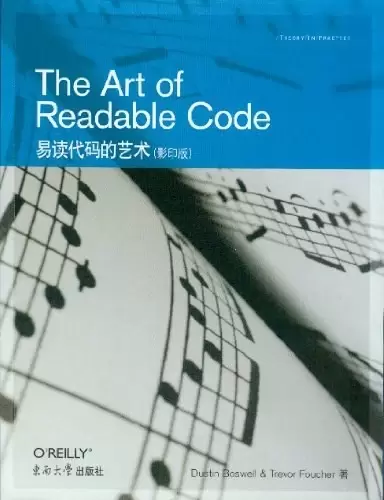
作者:DustinBoswell/TrevorFoucher
出版社:东南大学出版社
原作名:TheArtofReadableCode:SimpleandPracticalTechniquesforWritingBetterCode
出版年:2012-6
页数:190
定价:39.00元
ISBN:9787564134471
内容简介
······
本书分析了许多的“糟糕代码”(这些代码有很多是出自于他们自己之手),他们试图厘清为什么这些代码如此糟糕以及如何改进这些代码。他们得出的结论是:你必须写出让他人(这里也包括你自己)花费最少时间能够理解的代码。
作者简介
······
博斯韦尔(Dustin Boswell),毕业于加州理工学院,在谷歌公司从事过五年的Web信息采集基础设施和广告营销计划的研究工作。他先后构建过多个Web站点,目前的主要研究兴趣在于大数据的处理和机器学习领域的相关技术。
富彻(Trevor Foucher),过去十年中先后在微软公司担任Windows及安全相关产品的工程师、经理和技术领导者的职务,现任职于谷歌公司,主要从事谷歌广告营销计划和搜索基础设施的研究工作。
目录
······
PREFACE
1 CODE SHOULD BE EASY TO UNDERSTAND
What Makes Code "Better"?
The Fundamental Theorem of Readability
Is Smaller Always Better?
Does Time—Till—Understanding Conflict with Other Goals?
The Hard Part
Part One SURFACE—LEVEL IMPROVEMENTS
2 PACKING INFORMATION INTO NAMES
Choose Specific Words
Auoid Generic Names Like Imp and retual
Prefer Concrete Names ouer Abstract Names
Attaching Extra Information to a Name
How Lon.g Should a Name Be?
Use Name Formatting to Conuey Meaning
Summary
3 NAMES THAT CAN'T BE MISCONSTRUED
Example: Filter()
Example: Clip(text, length)
Prefer rain and max for (Inclusiue) Limits
Prefer first and last for Inelusiue Ranges
Prefer herin and end for.Inclusiue/Exclusiue Ranges
Naming Booleans
Matching Expectations of Users
Example: Eualuating Multiple Name Candidates
Summary
4 AESTHETICS
Why Do Aesthetics Matter?
BearranRe Line Breaks to Be Consistent and Compact
Use Methods to Clean Up Irregularity
Use Column Alignment When Helpful
Pick a Meaningful Order, and Use It Consistently
Organize Declarations into Blocks
Break Code into "Parafgraphs"
Personal Style uersus Consistency
Summary
5 KNOWING WHAT TO COMMENT
What NOT to Comment
Becording Your Thouyhts
Put Yourself in the Reader's Shoes
Final Thoughts——Getting Over Writer's Block
Summary
6 MAKING COMMENTS PRECISE AND COMPACT
Keep Comments Compact
Avoid Ambiguous Pronouns
Polish Sloppy Sentences
Describe Function Behavior Precisely
Use Input/Output Examples That Illustrate Corner Cases
State the Intent of Your Code
"Named Function Parameter" Comments
Use Information—Dense Words
Summary
Part Two SIMPLIFYING LOOPS AND LOGIC
7 MAKING CONTROL FLOW EASY TO READ
The Order of Arguments in Conditionals
The Order of if/else Blocks
The ?: Conditional Expression (a.k.a."Ternary Operator")
Avoid dogwhile Loops
Returning Early from a Function
The Infamous goto
Minimize Nesting
Can You Follow the Flow of Execution?
Summary
8 BREAKING DOWN GIANT EXPRESSIONS
Explaining Variables
Summary Variables
Using De Morgan's Laws
Abusing Short—Circuit Logic
Example: Wrestling with Complicated Logic
Breaking Down Giant Statements
Another Creative Way to Simplify Expressions
Summary
9 VARIABLES AND READABILITY
Eliminatinfg Variables
Shrink the Scope of Your Variables
Prefer Write—Once Variables
A Final Example
Summary
Part Three REORGANIZING YOUR CODE
10 EXTRACTING UNRELATED SUBPROBLEMS
Introductory Example: find Closest Loeation()
Pure Utility Code
Other General—Purpose Code
Create a Lot of General—Purpose Code
Project—Specific Functionality
Simplilying an Existing Interface
Reshaping an Interface to Your Needs
Taking Things Too Far
Summary
11 ONETASK ATA TIME
Tasks Can Be Small
Extracting Values from an Object
A Larger Example
Summary
12 TURNING THOUGHTS INTO CODE
Describing Logic Clearly
Knowing Your Libraries Helps
Applying This Method to Larger Problems
Summary
13 WRITING LESS CODE
Don't Bother Implementing That Feature——You Won't Need It
Question and Break Douan Your Requirements
Keeping Your Codebase Small
Be Familiar with the Libraries Around You
Example: Using Unix Tools Instead of Coding
Summary
Part Four SELECTED TOPICS
14 TESTING AND READABILITY
Make Tests Easy to Read and Maintain
What's Wrong with This Test?
Making This Test More Readable
Making Error Messages Readable
Choosing Good Test Inputs
Naming Test Functions
What Was Wrong with That Test?
Test—Friendly Deuelopment
Going Too Far
Summary
15 DESIGNING AND IMPLEMENTING A "MINUTE/HOUR COUNTER"
The Problem
Defining the Class Interface
Attempt 1: A Naiue Solution
Attempt 2: Conueyor Belt Design
Attempt 3: A Time—Bucketed Design
Comparing the Three Solutions
Summary
A FURTHER READING
INDEX
评论 ······
初级程序员必读
通俗易懂…慢慢学习中
2.0
读第二遍了,其中的写出易读代码的原则,仍然觉得非常受用。以后也应当会常常参考的。
评论前必须登录!
注册